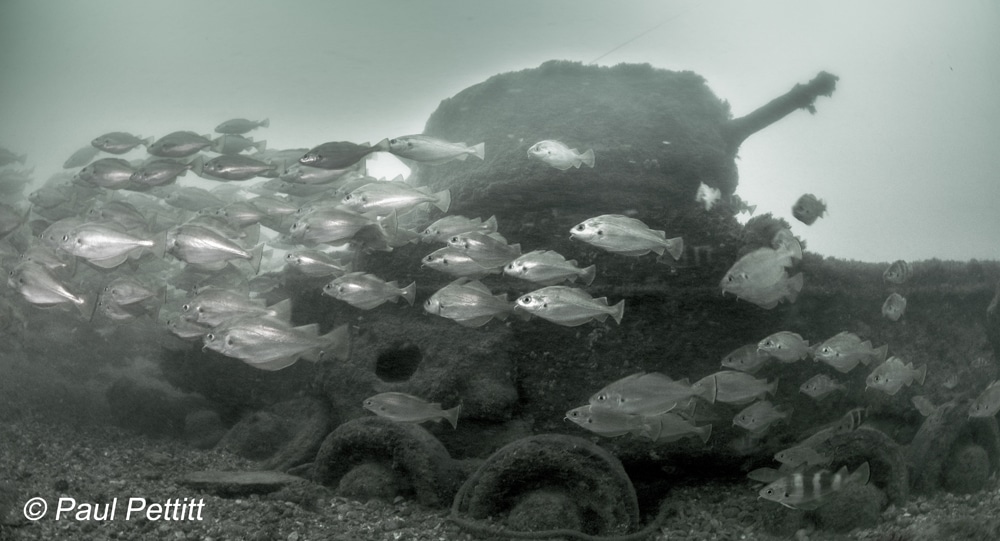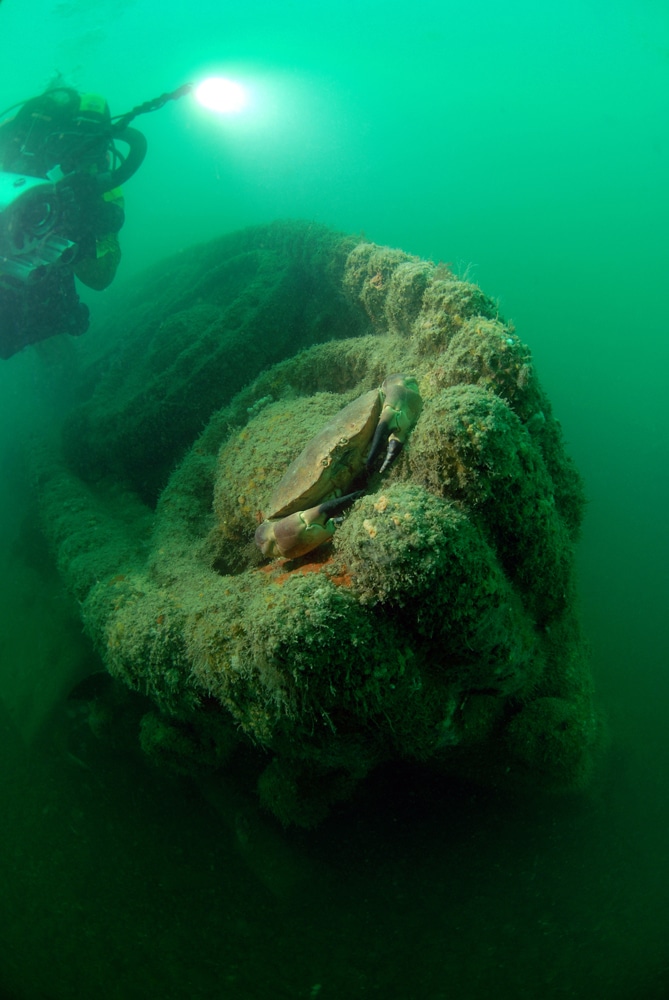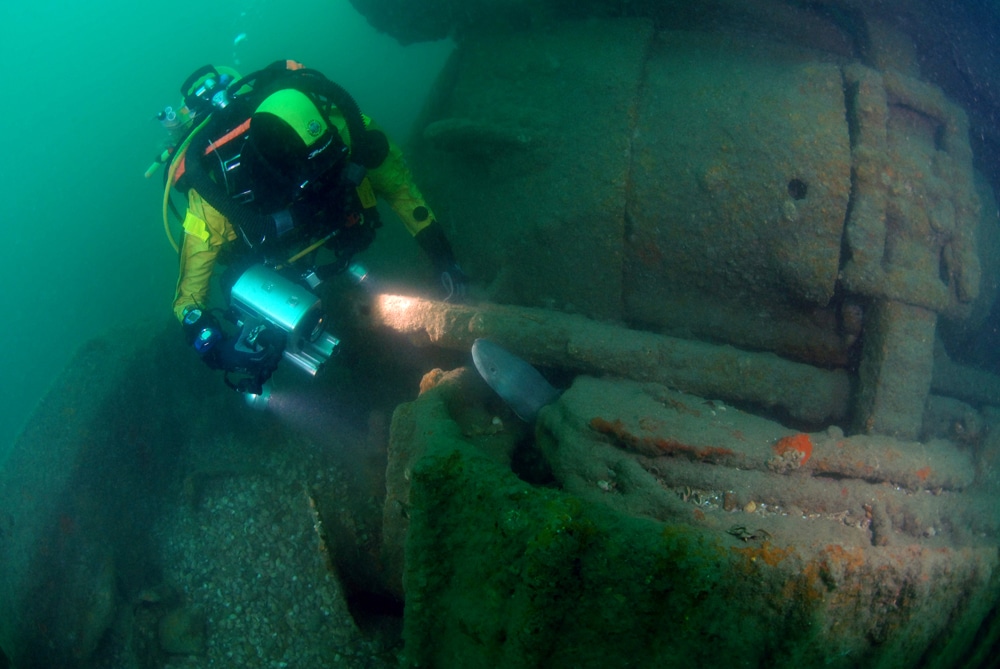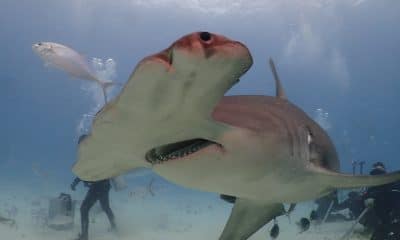News
Historic WWII sites given protection

![]() To mark the 75th anniversary of D-Day, six Second World War concrete structures built as replica landing craft for training, nine sunken army tanks, two armoured bulldozers and components of Mulberry floating harbours in Dorset, Devon and West Sussex are being granted protection by the Department for Digital, Culture, Media and Sport on the advice of Historic England.
To mark the 75th anniversary of D-Day, six Second World War concrete structures built as replica landing craft for training, nine sunken army tanks, two armoured bulldozers and components of Mulberry floating harbours in Dorset, Devon and West Sussex are being granted protection by the Department for Digital, Culture, Media and Sport on the advice of Historic England.
D-Day on 6 June 1944, codenamed Operation Overlord, was the greatest combined land, air and naval operation in history. It was a massive assault by the allies to invade Nazi-occupied Western Europe during the Second World War. 156,000 soldiers from Britain, America, Canada and France landed on the beaches of Normandy together with thousands of vehicles and supplies.
The many rehearsals and training exercises carried out along the coastline of Devon and Dorset together with the great engineering achievements of the Mulberry Harbours contributed to the success of the D-Day landings.
Culture Secretary Jeremy Wright said: “As we commemorate the 75th anniversary of D-Day, it is right that we continue to honour the memory of those who fought for peace in one of the decisive moments of the Second World War. It is also right to recognise the engineering and ingenuity that enabled that offensive. By listing the landing crafts, tanks, bulldozers and floating harbours we can ensure that future generations can learn about this important moment in our history.”
Duncan Wilson, Chief Executive of Historic England said: “Evidence of D-Day planning, rehearsal and the actual operation is all around us, on our coastline and in our waters helping to tell the D-Day Story. These tanks, armoured bulldozers, Mulberry Harbour components and concrete training landing craft are important as a witness to the great engineering achievements and logistical preparations around England’s coast for the largest amphibious invasion ever undertaken, on 6 June 1944. It is vital that we protect them as a memorial for future generations.”
VALENTINE TANK ASSEMBLAGE, STUDLAND BEACH, POOLE BAY, DORSET
(SCHEDULED MONUMENT)
Six weeks before D-Day in April 1944, troops arrived at Studland Beach in Dorset to rehearse an assault codenamed ‘Exercise Smash’. This was watched by Prime Minister Winston Churchill, King George VI and Supreme Allied Commander General Dwight D. Eisenhower from Fort Henry, an observation post built on a small cliff overlooking the bay.
Seven army tanks known as Duplex Drive (DD) Valentine tanks were lost during this exercise which went badly wrong. The Valentine was modified to be a ‘floating’ or amphibious tank that could leave its landing ship further out from shore than other tanks. However, during the exercise, these tanks sank with the loss of six crewmen shortly after driving off their landing craft. They ran into immediate difficulty when a sudden change in the weather adversely affected sea conditions. A valuable lesson was learned that these tanks couldn’t survive being launched too far from a beach and consequently on D-Day itself the tanks were released in shallow water.
The Valentine tanks in Poole Bay represent the largest surviving group of their type anywhere in the world.
SECOND WORLD WAR TANKS & BULLDOZERS, SELSEY BILL, WEST SUSSEX
(SCHEDULED MONUMENT)
In June 1944, the Allies opened a second front in Europe with Operation Neptune, comprising a largely amphibious invasion. In preparation for the assault, the 286-ton landing craft LCT(A)2428 was loaded with two Centaur cruiser tanks designed to fire at concrete targets such as pillboxes, two armoured D7 bulldozers designed to protect both the driver and the engine while clearing the invasion beaches of obstacles, one 4X4 car and a jeep. All the vehicles were lost on the night of 5/6 June when the landing craft broke down in the Solent while on route to the D-Day landings in Normandy. The vessel was taken under tow but capsized, spilling into the sea its cargo of tanks and armoured bulldozers intended to support the 3rd Canadian Infantry Division landing at Juno Beach. Sometime afterwards, the upturned vessel was deliberately sunk by gunfire from its tug, several miles to the east, off Selsey Bill in West Sussex. These armoured vehicles represent the only surviving group of their type in north-west Europe.
PHOENIX CAISSON (OUTER) OFF PAGHAM HARBOUR, WEST SUSSEX (SCHEDULED MONUMENT)
Mulberry Harbours were considered to be a major technological and engineering achievement of their time and contributed to the success of the D-Day landings. Designed and constructed by British military engineers during the Second World War, these huge artificial floating harbours were used by the allies to rapidly land enormous amounts of supplies and equipment in Normandy following the invasion.
The component parts were towed by tugs across the Channel, assembled by the military then sunk off Normandy to form a sheltered harbour to protect unloading ships. The Mulberries consisted of four major component parts and each had a code-name: Gooseberry (a network of artificial breakwaters), Bombardon (floating breakwaters), Whale (floating piers) and Phoenix (sunken breakwaters).
The outer or far Mulberry off Pagham Harbour which has been protected is a Phoenix caisson and it is a rare type of steel reinforced concrete unit that functioned as a sunken breakwater. Phoenix units varied in size between 2000 and 6000 tons. In June 1944 this particular unit was ‘parked’ off Pagham awaiting passage to Normandy. Its ballast tanks were pumped out to re-float it but as its tug wasn’t ready, the unit was re-sunk. However, during stormy weather, it swung around in the tide and became so damaged that it became unusable. It has remained in situ ever since.
PHOENIX CAISSON (INNER) OFF PAGHAM, WEST SUSSEX (SCHEDULED MONUMENT)
A rare concrete pier off Pagham has also been granted protection. Part of the Mulberry Harbour, this comprises a steel reinforced concrete platform which was designed to connect to offshore pontoons allowing more than one ship to unload its cargo at any one time. It is not yet clear how this sunken pier came to be located in the shallow waters off Pagham, but it is in an area commonly known by mariners as the ‘park’ which contains a large number of submerged or ‘parked’ Second World War components that were associated with Mulberry Harbour operations.
SECOND WORLD WAR CONCRETE REPLICA LANDING CRAFT AND TRAINING AREA, BRAUNTON BURROWS, DEVON – LISTED GRADE II
Six Second World War replica landing craft installations made of concrete and used for training American troops at Braunton Burrows in Devon have been protected. From September 1943, the North Devon coast became an Assault Training Center for American forces as part of the preparations for an allied attack on the Normandy beaches. Concrete replica landing craft were based on a 1942 American modification of the British Tank Landing Craft and were designed to represent the top deck of the craft with its front ramp lowered so troops could practice the embarking and disembarking of vehicles and personnel in advance of the D-Day landings. Additional aprons were added at the back of the craft and six foot high metal poles at the base edges supported either canvas or corrugated-tin screens to represent the sides of the craft.
The training structures were abandoned and a large number demolished in the late 20th century. A memorial service is held on 6 June each year at the replica craft structures at Braunton Burrows to recognise and remember the important role that the members of the allied forces played in the liberation of Europe.
A further concrete structure newly listed at Grade II at the Assault Training Center, to the north of the landing craft, illustrates the range of facilities offered here. The practice rocket, or ‘Bazooka’, wall was built deep within the sand dunes in 1943, a target butt for the Allied forces. A rare survival of its type, the wall is largely intact and the visible repairs provide evidence of its use.
The majority of the newly protected structures have been identified by military enthusiasts the Friends of the Assault Training Center. They will be working with Historic England, North Devon Area of Outstanding Natural Beauty and Christie Estates to conserve and manage them after the commemoration of the 75th anniversary of D-Day on 6 June to ensure they are accessible for more people to enjoy.
For more information visit the Historic England website by clicking here.
Blogs
The Ocean Cleanup Breaks 10,000,000 KG Barrier

The Ocean Cleanup, the global non-profit project, has removed a verified all-time total of ten million kilograms (22 million lbs.) of trash from oceans and rivers around the world – approximately the same weight as the Eiffel Tower.
To complete its mission of ridding the oceans of plastic, The Ocean Cleanup uses a dual strategy: cleaning up the Great Pacific Garbage Patch (GPGP) to remove the plastic already afloat in the oceans, while stopping the flow of plastic from the world’s most polluting rivers.
Through cleaning operations in the GPGP and in rivers in eight countries, the cumulative total of trash removed has now surpassed ten million kilograms. This milestone demonstrates the acceleration of The Ocean Cleanup’s impact, while underlining the astonishing scale of the plastic pollution problem and the need for continued support and action.
While encouraging for the mission, this milestone is only a staging point: millions more tons of plastic still pollute our oceans and The Ocean Cleanup intends to continue learning, improving and innovating to solve this global catastrophe.
This announcement comes as governments from around the world meet to continue negotiations to develop a new legally binding instrument to end plastic pollution at INC4 in Ottawa, Canada. Representatives of The Ocean Cleanup will be in attendance and the organization will be urging decision-makers to collaborate towards a comprehensive and ambitious global treaty which addresses plastic at all stages of its life cycle and in all marine environments worldwide, including in areas beyond national jurisdiction.
It is encouraging to see that the need for remediation is reflected in the various options for potential treaty provisions. It is essential that the final treaty contains clear targets for the remediation of legacy plastic pollution, and reduction of riverine plastic emissions.
Tackling plastic pollution requires innovative and impactful solutions. The treaty should therefore incentivize the innovation ecosystem by fostering innovations that make maximal use of data, technology and scientific knowledge – such as those designed and deployed by The Ocean Cleanup.
‘After many tough years of trial and error, it’s amazing to see our work is starting to pay off – and I am proud of the team who has brought us to this point.’ said Boyan Slat, Founder and CEO of The Ocean Cleanup. ‘While we still have a long way to go, our recent successes fill us with renewed confidence that the oceans can be cleaned.’
The Ocean Cleanup was founded in 2013 and captured its first plastic in 2019, with the first confirmed catch in the GPGP coming soon after the deployment of Interceptor 001 in Jakarta, Indonesia. After surpassing one million kilograms of trash removed in early 2022, the non-profit project has since progressed to the third iteration of its GPGP cleaning solution, known as System 03, and a network of Interceptors currently covering rivers in eight countries, with more deployments set for 2024.
About The Ocean Cleanup
The Ocean Cleanup is an international non-profit organization that develops and scales technologies to rid the world’s oceans of plastic. They aim to achieve this goal through a dual strategy: stemming the inflow via rivers and cleaning up the legacy plastic that has already accumulated in the ocean. For the latter, The Ocean Cleanup develops large-scale systems to efficiently concentrate the plastic for periodic removal. This plastic is tracked and traced through DNV’s chain of custody model to certify claims of origin when recycling it into new products. To curb the tide via rivers, The Ocean Cleanup has developed Interceptor™ solutions to halt and extract riverine plastic before it reaches the ocean. Founded in 2013 by Boyan Slat, The Ocean Cleanup now employs a broadly multi-disciplined team of approximately 140. The foundation is headquartered in Rotterdam, the Netherlands.
For more information, visit: theoceancleanup.com and follow @theoceancleanup on social media.
Marine Life & Conservation
Steve Backshall to headline Shark Trust’s flagship event: For the Love of Sharks

Join a host of amazing, shark loving, speakers including Steve Backshall and the Shark Trust team for an evening celebrating shark conservation at the Royal Geographical Society in London this November.
Date: 29th November 2024
Time: 6-10pm
Location: Royal Geographical Society, London
Tickets: https://www.sharktrust.org/Event/flos24
The event will be a celebration of all things shark. Those lucky enough to get hold of tickets will hear from engaging guest speakers with a passion for sharks.
The line-up includes (*subject to change if unforeseen circumstances arise)
Steve Backshall: One of television’s busiest presenters, BAFTA award-winning wildlife expert Steve has been passionate about the wild world ever since he was young.
Steve’s impressive TV career has taken him all around the world, investigating a wide array of species and environments. Steve has filmed over 100 hours of children’s wildlife programmes with the BAFTA award winning Deadly 60 franchise and recently, with Sky Nature, for his new series ‘Whale with Steve Backshall’. He has been a patron for the Shark Trust for 10 years.
Simon Rogerson: is a photojournalist specialising in natural history, diving and the sea.
He is editor of SCUBA magazine, the official journal of the British Sub-Aqua Club. Simon started his career as a crime reporter but gravitated towards his ‘less depressing’ interest in underwater exploration, joining the staff of DIVE magazine in 1999. In 2005 he was named ‘Editor of the Year’ in the PPA’s Independent Publishing Awards. Simon also works as a freelance writer, contributing frequently to the Sunday Times and Telegraph, in addition to BBC Wildlife, Esquire, and a host of international diving magazines. He is the author of a book, Dive Red Sea, published by Ultimate Sports. Now based in Berkshire, Simon has been a Patron of the Shark Trust for 20 years.
More speakers to be announced soon. Head to the Shark Trust website to learn more.
The evening will also allow guests the final chance to see the Oceanic 31, shark art exhibition. Some of the artwork will be auctioned/raffled at the event, while the rest will be auctioned online to raise money for the Shark Trust Oceanic Programme.
For the Love of Sharks is an evening with something for everyone who is interested and fascinated by sharks. Join the Shark Trust, their Patrons, Trustees and Staff, along with a host of supporters for this celebration of shark conservation.
For more information or to buy a ticket: https://www.sharktrust.org/Event/flos24
-

 News3 months ago
News3 months agoCapturing Critters in Lembeh Underwater Photography Workshop 2024: Event Roundup
-

 Marine Life & Conservation Blogs3 months ago
Marine Life & Conservation Blogs3 months agoCreature Feature: Swell Sharks
-

 Blogs2 months ago
Blogs2 months agoMurex Resorts: Passport to Paradise!
-

 Blogs2 months ago
Blogs2 months agoDiver Discovering Whale Skeletons Beneath Ice Judged World’s Best Underwater Photograph
-

 Gear Reviews3 weeks ago
Gear Reviews3 weeks agoGEAR REVIEW – Revolutionising Diving Comfort: The Sharkskin T2 Chillproof Suit
-

 Gear Reviews3 months ago
Gear Reviews3 months agoGear Review: Oceanic+ Dive Housing for iPhone
-

 Marine Life & Conservation2 months ago
Marine Life & Conservation2 months agoSave the Manatee Club launches brand new webcams at Silver Springs State Park, Florida
-

 News2 months ago
News2 months agoPADI Teams Up with Wellness Brand Neuro to Drive Ocean Change and Create a Blue State of Mind

















